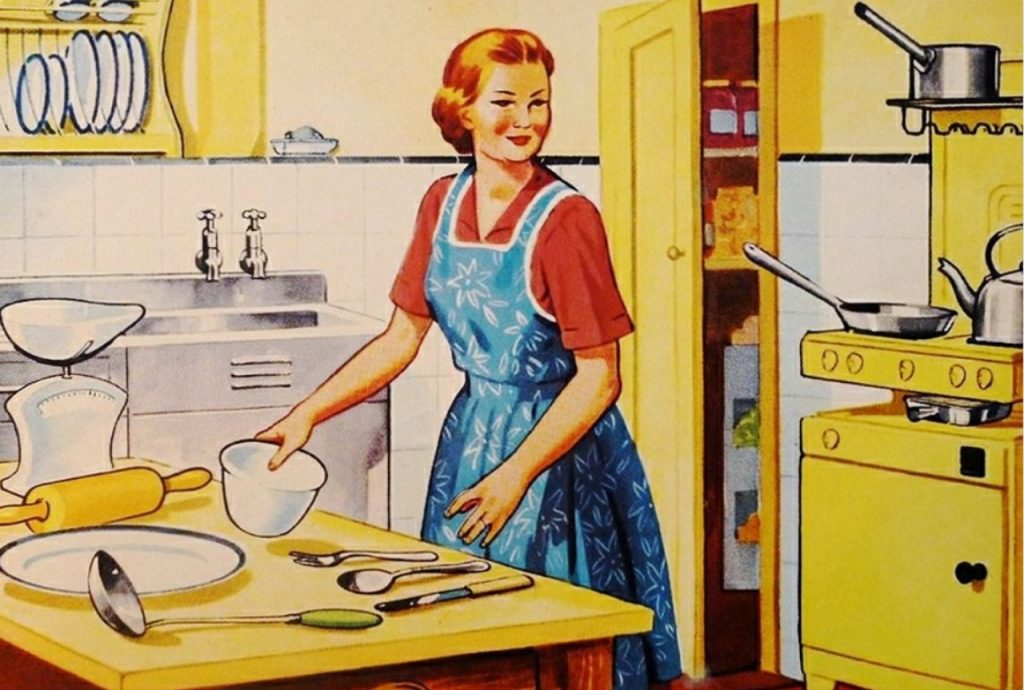This article explores how the culture of gender violence results directly from the patriarchal capitalist economic system based on exploitation and oppression.
Cultural Roles and Stereotypes Are Embedded in a Social System
From the moment we are born, the culture that surrounds us accustoms us to pigeonholing others and ourselves into a series of roles. It begins by assigning us a sex, gender, religion, upbringing, and so on, depending on the part of the world into which we are born, the social class to which we belong, and the color of our skin. Often, these categories are attached to us with neither consent nor conscience, well before we can develop a level of consciousness that allows us to understand the real meaning of these roles and, especially, the influence they will have in our future, both as tools (or not) of socialization and as definitions of ourselves that we may or may not use.
These roles allow us at least to acclimate ourselves to the social and cultural system within which we find ourselves living as individuals and, at the same time, these categories — because they have been integrated into a system — allow us to establish who does or does not conform to that system. They allow the establishment of values and real social dogmas people are pushed to adhere to in various conscious and unconscious forms.
This mechanism also works in bourgeois society and, indeed, today has at its disposal ways to create and disseminate culture, ideology, consensus, and common practices that are incomparable with anything in the past.
Many sociologists — particularly during the 1960s and 1970s, when these values were systematically challenged — have studied precisely how the concept of stereotype develops from these dynamics. First and foremost, the influence a stereotype has on a community is realized through discrimination, although that is not the only way.
The Gender Stereotype: A Patriarchal Instrument of Oppression of Women
A stereotype that permeates the culture and is integrated into a social system carries with it the power to rewrite the past, to present history in a way that accommodates the stereotype and makes it coherent on its own terms. For evidence, consider the historical narrative — built upon the gender stereotype — that states that since the birth of the first communities of hominids, work was clearly divided between women, who dealt exclusively with childcare, and men who worked as “hunters” — without whom no one would eat. This stereotype has been disproved by the archaeological and anthropological studies that reveal for us that even in the Neolithic period, there were women hunters, and above all that the roles in these initial communities were not defined hierarchically. Often, the first source of sustenance for the group was not what men hunted, but the fruits and herbs that women harvested. Nevertheless, the other narrative — aimed at telling us that women cannot survive without men who “bring home the bacon” — has been built in the image of a society such as ours today and still runs deep in the common imagination.
This vision of history is perceived as “scientific” and is still what children study in their early years of school. That has led to the development of a cultural substrate that solidifies the stereotype and the resulting historical justification of the disparity between men and women that has cascaded through every area of society for centuries: work, intellectual pursuits, science, the family, and so on.
The gender stereotype has given rise to a host of distorted narratives regarding the role of women. For example, the narrative that women are “emotional” has for years justified their exclusion from the intellectual sphere, because they are considered too naïve or prone to sentimentality to study scientific phenomena or to be an integral part of political processes. The stereotype remains so strong, even today, that it has led to even the most progressive contemporary intellectuals to produce objectively paternalistic positions, linked to a reformist approach to patriarchal oppression — as in the recent example of Professor Alessandro Barbero’s statement that “all it will take is to raise a few more generations of conscious young people and the situation will change.” There has been no systematic break with gender stereotypes in the history of modern Leftist and communist parties; prior to second-wave feminism, these parties had very questionable positions on the role of women in politics and in the community, and even today a common “minimum” level of feminism cannot be taken for granted on the Left, let alone a class feminism.
The Communist Party of the Soviet Union itself, after having promoted the most advanced and audacious reforms on women’s rights as early as 1918, eventually capitulated on this front to counter-revolutionary pressures, restoring various material and legal premises of women’s gender role in patriarchy. The Italian Communist Party (PCI), in its eternal pursuit of the Christian Democrats on their own terrain, was responsible for an enormous weakening of the push toward an anti-capitalist, class-based women’s movement in Italian society. It has also confirmed the conservative political character of Stalinism in its different national variants and has found itself in the “right wing” on several issues even in comparison to liberal-democratic parties. The issue of divorce provides an example: only pressure from below and beyond led the PCI to support the struggle around the issue of divorce and break with the “sacred and inseparable” character of marriage.
In addition to its false historical roots, the gender stereotype is also based, perhaps more than anything, on the notion that the biological differences between men and women define the social role they should have. As it goes, women “predisposed” to childcare and other forms of care must stay at home to tend to the children, the elderly, and the men; meanwhile, men “inclined” to physical prowess, using their intellect, and possessing a functional emotional detachment from whatever gets in the way of achieving goals — such as “feminine” emotionalism — are instead led to manual and/or intellectual work and to hold positions of power both within the family unit and in society more broadly. This explains, at least at a superstructural level, the great absence of women from the world of work. But it is the structural result of a patriarchal capitalist society that, in order to ensure the exploitation of the workforce for profit, limited the inclusion of women in workplaces as a way to recreate in the family the capitalist relationship of economic control in the form of man over woman, which in turn reinforces the incidents of violence and discrimination that women themselves suffer within the family and throughout their entire communities.
The stereotype even dictates the narrative on gender violence. Women are routinely and immediately described as “victims” in the media, on the TV news, and even in awareness campaigns on the topic by institutions. Implying the victimization of those who have suffered violence leaves the impression of fragile subjects unable to defend themselves or respond — a characterization that obviously does not apply in the courtroom, because there we speak of the law, and we are “all equal” before the law. Of course, if you are poor, you should be punished more harshly, the better to learn from your mistakes. If you are a woman, you’re not very credible. If you are queer, you are not a reliable person and your problems are unimportant — practical confirmation of which came with the sinking in late October of the DDL Zan, the bill in the Italian Senate to establish a law against discrimination based on sexual orientation, gender, and gender identity.
Why Does Capitalism Repurpose the Gender Stereotype?
Capitalism developed from the already existing patriarchal system, which provided for an economic and social hierarchy closely linked to the conceptions and relationships of pre-capitalist societies with the various religions — as German sociologist Max Weber (1864–1920) pointed out — that places women below men on the social scale and dependent on them economically. Capitalism has dragged this structure along, trying to modernize it and make it more functional for the newer system. Beginning from structural needs that are typical of the new social form that is capitalism, such as making profits and consolidating forms of direct and indirect social control, social organs that would allow the widespread reproduction of the exploited/exploiter dichotomy began to be built: through the family, schools, workplaces, and so on. The dichotomous man/woman relationship that is typical of patriarchy exists in parallel.
Initially, this meant keeping women out of the world of productive work, especially more advanced industrial work, forcing them or work in the countryside or to take care of their children and husbands at home — husbands who were at the time routinely working up to 12 hours a day. With the advent of modern industrial technology, of machines, the increasing employment of women in sectors considered more suitable to a female workforce came along with starvation wages, much lower than those paid to men, since it was assumed that only men needed to be paid wages to support an entire family.
This represented a huge additional gain for the capitalists, but over the longer term allowed women to become part of the organized labor movement and develop class consciousness and allowed for the intertwining of women’s emancipation and that of the working class as part of the same struggle. It is precisely the great cycles of struggle, along with huge and tragic events such as World War I, that consolidated women as a part of the working class that could simply not be ignored, despite the fact that there remained a very strong prejudice — even among women themselves — that to some extent men remained the ones on whom to depend.
The social fact that women have been, and still are, convinced that their role is one of support and/or subjugation to men cannot be explained solely by what sociologists call “self-fulfilling prophecy” — a discriminated subject taking actions that confirm a stereotype precisely because of living under stressful conditions that flow from awareness of being subjected to discrimination. The root of this can be found in the continuation of the concept, which the entry of women into the labor market did not automatically eradicate. It is no coincidence that even today, the gender gap in Europe averages around 29.6 percent.
Capitalism’s structural need to incorporate the patriarchy for these and various other economic expediencies has obviously meant that the values promoted by patriarchy were also grafted to the culture, political, and social doctrine of this system, to the point of reproducing it within its families and schools This makes these values a pillar of what Marx referred to as the dominant ideology1Translator’s note: “The ideas of the ruling class are in every epoch the ruling ideas, i.e. the class which is the ruling material force of society, is at the same time its ruling intellectual force.” Karl Marx, The German Ideology (1845–46). — despite all the screaming today about the unbridled spread of “gender ideology.”
When Marx wrote in his Economic & Philosophic Manuscripts of 1844 of the exploitation of workers in the industrial production process, he grasped the importance of how this exploitation assumes a division between manual and intellectual work. This division harms workers, making them even more the slaves of the master, who no longer owns only the means of production but also the knowledge and expertise associated with the overall production system. The worker is but one part necessary to create the goods that get sold in the market.2“The accumulation of capital increases the division of labor, and the division of labor increases the number of workers. Conversely, the number of workers increases the division of labor, just as the division of labor increases the accumulation of capital. With this division of labor on the one hand and the accumulation of capital on the other, the worker becomes ever more exclusively dependent on labor, and on a particular, very one-sided, machine-like labor at that. Just as he is thus depressed spiritually and physically to the condition of a machine and from being a man becomes an abstract activity and a belly, so he also becomes ever more dependent on every fluctuation in market price, on the application of capital, and on the whim of the rich. … In the factory system this situation of the worker reaches its climax.” (Karl Marx, Economic & Philosophic Manuscripts of 1844, “Wages of Labor.”
We can think of the division of gender roles within capitalism in the same way. The woman, considered the worker of the family, is given the opportunity to have only one role within a society that is, to be understood as a whole, composed of several roles. The woman becomes even more dependent on the master, which in this case is the man, not only economically like the worker, but especially to be able to read the world. On top of all this, compared to the worker, the woman is deprived of education, socialization, class organization, and the social progress that men have won with the passage of time. This means that even today women are taught to be submissive, docile, and compliant to their first paternal authority, and then to teachers, and then to employers. To this day, we are still told not to challenge too much “attention” or any of those small daily harassments we suffer just by walking down the street. Indeed, we are encouraged to be proud of these occurrences, because they are a sign that we are attractive prey for males. To this day, we are taught to be afraid of repercussions, to feel inferior and insufficiently intelligent to achieve goals, and to seek our satisfactions in a man, a son, and a “well-managed” home.
Despite centuries of domestication, conformism, and patriarchal indoctrination, however, we have never given up. Our condition of being doubly exploited has always taught us to fight twice as hard to win what belongs to us … and that we’re as good as anyone! No religion, teachings, violence, abuse, or ideology can stop us, because we know the identity of our enemy.
We are not just tired of all this macho, sexist culture, and we are not just ready to destroy it, but above all we are ready to continue to fight against the system that feeds it, united side by side. That’s because even if we repudiate your impositions on us to be good mothers, daughters, and wives, we feel an obligation to ourselves and to our sisters to come to be the progenitors of a new world, one free from exploitation and oppression.
We are no longer satisfied with crumbs. We want bread — and roses, too!
First published in Italian on November 24 in La Voce delle Lotte.
Translation by Scott Cooper
Notes
| ↑1 | Translator’s note: “The ideas of the ruling class are in every epoch the ruling ideas, i.e. the class which is the ruling material force of society, is at the same time its ruling intellectual force.” Karl Marx, The German Ideology (1845–46). |
|---|---|
| ↑2 | “The accumulation of capital increases the division of labor, and the division of labor increases the number of workers. Conversely, the number of workers increases the division of labor, just as the division of labor increases the accumulation of capital. With this division of labor on the one hand and the accumulation of capital on the other, the worker becomes ever more exclusively dependent on labor, and on a particular, very one-sided, machine-like labor at that. Just as he is thus depressed spiritually and physically to the condition of a machine and from being a man becomes an abstract activity and a belly, so he also becomes ever more dependent on every fluctuation in market price, on the application of capital, and on the whim of the rich. … In the factory system this situation of the worker reaches its climax.” (Karl Marx, Economic & Philosophic Manuscripts of 1844, “Wages of Labor.” |










